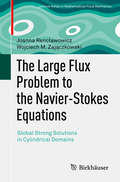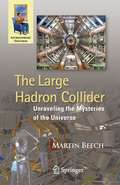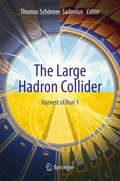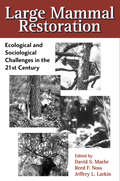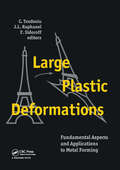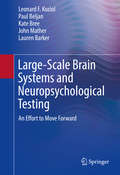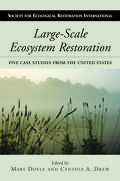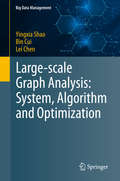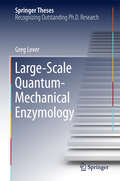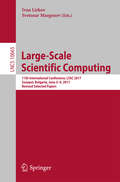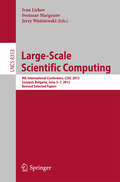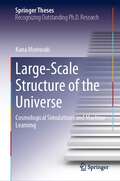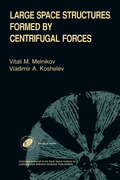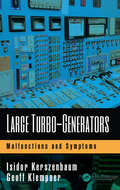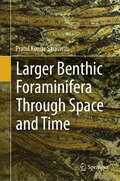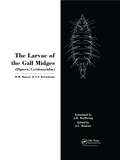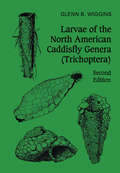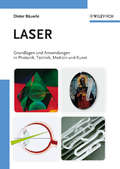- Table View
- List View
Large Energy Storage Systems Handbook (Mechanical and Aerospace Engineering Series)
by Frank S. Barnes Jonah G. LevineIn the current push to convert to renewable sources of energy, many issues raised years ago on the economics and the difficulties of siting energy storage are once again being raised today. When large amounts of wind, solar, and other renewable energy sources are added to existing electrical grids, efficient and manageable energy storage becomes a
The Large Flux Problem to the Navier-Stokes Equations: Global Strong Solutions in Cylindrical Domains (Advances in Mathematical Fluid Mechanics)
by Joanna Rencławowicz Wojciech M. ZajączkowskiThis monograph considers the motion of incompressible fluids described by the Navier-Stokes equations with large inflow and outflow, and proves the existence of global regular solutions without any restrictions on the magnitude of the initial velocity, the external force, or the flux. To accomplish this, some assumptions are necessary: The flux is close to homogeneous, and the initial velocity and the external force do not change too much along the axis of the cylinder. This is achieved by utilizing a sophisticated method of deriving energy type estimates for weak solutions and global estimates for regular solutions—an approach that is wholly unique within the existing literature on the Navier-Stokes equations. To demonstrate these results, three main steps are followed: first, the existence of weak solutions is shown; next, the conditions guaranteeing the regularity of weak solutions are presented; and, lastly, global regular solutions are proven. This volume is ideal for mathematicians whose work involves the Navier-Stokes equations, and, more broadly, researchers studying fluid mechanics.
The Large Hadron Collider
by Martin BeechIt may at first seem that the world of subatomic physics is far removed from our every day lives. Isn't it all just a waste of time and taxpayers' money? Hopefully, all who read this book will come to a different conclusion. Collider physics is all about our origins, and this aspect alone makes it worthy of our very best attention. The experiments conducted within the vast collider chambers are at the forefront of humanity's quest to unweave the great tapestry that is the universe. Everything is connected. Within the macrocosm is the microcosm. By knowing how matter is structured, how atoms and elementary particles interact, and what forces control the interactions between the particles, we discover further clues as to why the universe is the way it is, and we uncover glimpses of how everything came into being. The Large Hadron Collider (LHC), in the process of coming online at CERN, is the world's largest and most complex machine. It represents the pinnacle of human ingenuity, and its physical characteristics, costs, and workings astound us at every turn. We are literally humbled by the machine that has been produced through a grand international collaboration of scientists. This book is about what those scientists hope to discover with the LHC, for hopes do run high, and there is much at stake. Careers, reputations and prestigious science prizes will be realized, and possibly lost, in the wake of the results that the LHC will produce. And there are risks, real and imagined. The LHC will probe the very fabric of matter and it will help us understand the very weft and the weave of the universe.
The Large Hadron Collider: The Extraordinary Story of the Higgs Boson and Other Stuff That Will Blow Your Mind
by Don LincolnAn insider's history of the world's largest particle accelerator, the Large Hadron Collider: why it was built, how it works, and the importance of what it has revealed.Since 2008 scientists have conducted experiments in a hyperenergized, 17-mile supercollider beneath the border of France and Switzerland. The Large Hadron Collider (or what scientists call "the LHC") is one of the wonders of the modern world—a highly sophisticated scientific instrument designed to re-create in miniature the conditions of the universe as they existed in the microseconds following the big bang. Among many notable LHC discoveries, one led to the 2013 Nobel Prize in Physics for revealing evidence of the existence of the Higgs boson, the so-called God particle. Picking up where he left off in The Quantum Frontier, physicist Don Lincoln shares an insider's account of the LHC's operational history and gives readers everything they need to become well informed on this marvel of technology. Writing about the LHC's early days, Lincoln offers keen insight into an accident that derailed the operation nine days after the collider's 2008 debut. A faulty solder joint started a chain reaction that caused a massive explosion, damaged 50 superconducting magnets, and vaporized large sections of the conductor. The crippled LHC lay dormant for over a year, while technical teams repaired the damage.Lincoln devotes an entire chapter to the Higgs boson and Higgs field, using several extended analogies to help explain the importance of these concepts to particle physics. In the final chapter, he describes what the discovery of the Higgs boson tells us about our current understanding of basic physics and how the discovery now keeps scientists awake over a nagging inconsistency in their favorite theory.As accessible as it is fascinating, The Large Hadron Collider reveals the inner workings of this masterful achievement of technology, along with the mind-blowing discoveries that will keep it at the center of the scientific frontier for the foreseeable future.
The Large Hadron Collider
by Thomas Schörner-SadeniusThis comprehensive volume summarizes and structures the multitude of results obtained at the LHC in its first running period and draws the grand picture of today's physics at a hadron collider. Topics covered are Standard Model measurements, Higgs and top-quark physics, flavour physics, heavy-ion physics and searches for super symmetry and other extensions of the Standard Model. Emphasis is placed on overview and presentation of the lessons learned. Chapters on detectors and the LHC machine and a thorough outlook into the future complement the book. The individual chapters are written by teams of expert authors working at the forefront of LHC research, typically one from each of the two multi-purpose experiments ATLAS and CMS and one from theory.
Large Herbivores (World of Animals: Mammals #5)
by Amy-Jane Beer Pat MorrisThis book offers a detailed introduction to large plant eaters, including elephants, rhinos, hippos, horses and zebras, camels and llamas, pigs and peccaries and tapirs. Introduces the animals habitat, status, scientific name, and fascinating facts about each.
Large Mammal Restoration: Ecological And Sociological Challenges In The 21St Century
by David Maehr Jeffery L. Larkin Melvin E. Sunquist Reed F. NossEvidence is mounting that top carnivores and other large mammals play a pivotal role in regulating ecosystem health and function, yet those are the species that are most likely to have been eliminated by past human activities. In recent decades, numerous efforts have been undertaken to return some of the species that were previously extirpated on local or regional scales.Large Mammal Restoration brings together for the first time detailed case studies of those efforts, from restoring elk in Appalachia to returning bison herds to the Great Plains to the much-publicized effort to bring back the gray wolf to Yellowstone National Park. Together these case studies offer important lessons and new ways of thinking for wildlife managers and conservation biologists involved with restoration programs. Sections examine: approaches to determining the feasibility of a restoration program critical hands-on aspects of restoring large mammals obtaining public input into the process and gaining community support for programs the potential of some species to return without direct human intervention, and what can be done to facilitate that natural colonization An introductory chapter by Reed F. Noss explores some of the reasons for restoring large mammals, as well as some of the ecological and social complications, and a concluding overview by David S. Maehr discusses the evolutionary importance of large mammal restoration. Contributors include Paul C. Paquet, Barbara Dugelby, Steven H. Fritts, Paul R. Krausman, Larry D. Harris, Johnna Roy, and many others. Large Mammal Restoration brings together in a single volume essential information on the lessons learned from previous efforts, providing an invaluable resource for researchers and students of conservation biology and wildlife management as well as for policymakers, restoration advocates, and others involved with the planning or execution of a restoration program.
Large Plastic Deformations: Proceedings of the international seminar MECAMAT'91, Fontainebleau, France, 7-9 August 1991
by C.TEODOSIU; J.L.RAPHANEL; F.SIDOROFFThis volume covers topics involving large plastic deformation of metallic materials. These proceedings offer an overview of the synergism achieved by combining microstructural characterization and understanding, mechanical modelling and experiments, numerical analysis and computation.
Large-Scale Brain Systems and Neuropsychological Testing
by Leonard F. Koziol Paul Beljan Kate Bree John Mather Lauren BarkerThis leading-edge volume offers a new framework forneuropsychological testing rooted in the current evidence base on large-scalebrain system interactions. Expert coverage brings traditional discrete areas ofcognitive functioning (e. g. , attention, memory) in line with highly nuancedrelationships between cortical and subcortical processing. The new findingspoint to more accurate and targeted testing, as authors expand on the judiciousaddition of nonstandardized methods to core diagnostic tools and the underusedcapacity of neuropsychological testing to assess social behavior andpersonality. The book's emphasis on cognition in context gives practitioners betterunderstanding of assessment and evaluation, leading to improved diagnosis,treatment, and outcomes for individuals as well as significant improvements inthe field. This innovative reference: Reframes cognitive functioning in light of current data on brain interconnectivity. Critiques current methods of neuropsychological test interpretation. Reviews known, useful interpretive methodologies within a new context. Features instructive case examples emphasizing accurate historical and test data. Revisits the strengths and limitations of the bell curve construct. Examines the interpretive significance of pathognomonic signs. Details strategies for making neuropsychological evaluations more clinically relevant. Large-Scale Brain Systems and NeuropsychologicalTesting combines current findings, clinicalsense, and common sense to ground neuropsychologists, school psychologists,child psychologists, and clinical social workers in the effective assessment ofreal-world functioning.
Large-Scale Ecosystem Restoration: Five Case Studies from the United States (Science Practice Ecological Restoration)
by Cynthia Drew Mary DoyleLarge-Scale Ecosystem Restoration presents case studies of five of the most noteworthy large-scale restoration projects in the United States: Chesapeake Bay, the Everglades, California Bay Delta, the Platte River Basin, and the Upper Mississippi River System. These projects embody current efforts to address ecosystem restoration in an integrative and dynamic manner, at large spatial scale, involving whole (or even multiple) watersheds, and with complex stakeholder and public roles. Representing a variety of geographic regions and project structures, the cases shed light on the central controversies that have marked each project, outlining * the history of the project * the environmental challenges that generated it * the difficulties of approaching the project on an ecosystem-wide basis * techniques for conflict resolution and consensus building * the ongoing role of science in decision making * the means of dealing with uncertainties A concluding chapter offers a guide to assessing the progress of largescale restoration projects. Large-Scale Ecosystem Restoration examines some of the most difficult and important issues involved in restoring and protecting natural systems. It is a landmark publication for scientists, policymakers, and anyone working to protect or restore landscapes or watersheds.
Large-scale Graph Analysis: System, Algorithm and Optimization (Big Data Management)
by Yingxia Shao Bin Cui Lei ChenThis book introduces readers to a workload-aware methodology for large-scale graph algorithm optimization in graph-computing systems, and proposes several optimization techniques that can enable these systems to handle advanced graph algorithms efficiently. More concretely, it proposes a workload-aware cost model to guide the development of high-performance algorithms. On the basis of the cost model, the book subsequently presents a system-level optimization resulting in a partition-aware graph-computing engine, PAGE. In addition, it presents three efficient and scalable advanced graph algorithms – the subgraph enumeration, cohesive subgraph detection, and graph extraction algorithms. This book offers a valuable reference guide for junior researchers, covering the latest advances in large-scale graph analysis; and for senior researchers, sharing state-of-the-art solutions based on advanced graph algorithms. In addition, all readers will find a workload-aware methodology for designing efficient large-scale graph algorithms.
Large-Scale Mammalian Cell Culture Technology (Biotechnology And Bioprocessing Ser. #10)
by LubinieckiAn interdisciplinary approach, integrating biochemistry, biology, genetics, and engineering for the effective production of protein pharmaceuticals. The volume offers a biological perspective of large-scale animal cell culture and examines diverse processing strategies, process management, regulator
Large-Scale Perturbations of Magnetohydrodynamic Regimes
by Vladislav ZheligovskyNew developments for hydrodynamical dynamo theory have been spurred by recent evidence of self-sustained dynamo activity in laboratory experiments with liquid metals. The emphasis in the present volume is on the introduction of powerful mathematical techniques required to tackle modern multiscale analysis of continous systems and there application to a number of realistic model geometries of increasing complexity. This introductory and self-contained research monograph summarizes the theoretical state-of-the-art to which the author has made pioneering contributions.
Large-Scale Quantum-Mechanical Enzymology
by Greg LeverThis work establishes linear-scaling density-functional theory (DFT) as a powerful tool for understanding enzyme catalysis, one that can complement quantum mechanics/molecular mechanics (QM/MM) and molecular dynamics simulations. The thesis reviews benchmark studies demonstrating techniques capable of simulating entire enzymes at the ab initio quantum-mechanical level of accuracy. DFT has transformed the physical sciences by allowing researchers to perform parameter-free quantum-mechanical calculations to predict a broad range of physical and chemical properties of materials. In principle, similar methods could be applied to biological problems. However, even the simplest biological systems contain many thousands of atoms and are characterized by extremely complex configuration spaces associated with a vast number of degrees of freedom. The development of linear-scaling density-functional codes makes biological molecules accessible to quantum-mechanical calculation, but has yet to resolve the complexity of the phase space. Furthermore, these calculations on systems containing up to 2,000 atoms can capture contributions to the energy that are not accounted for in QM/MM methods (for which the Nobel prize in Chemistry was awarded in 2013) and the results presented here reveal profound shortcomings in said methods.
Large-Scale Scientific Computing
by Ivan Lirkov Svetozar MargenovThepapersinthis volumewerepresentedatthe4thInternationalConferenceon Large-Scale Scienti'c Computations ICLSSC 2003. It was held in Sozopol, B- garia, June 4-8, 2003. The conference was organized and sponsored by the C- tral Laboratory for Parallel Processing at the Bulgarian Academy of Sciences. Support was also provided from the Center of Excellence "BIS 21" (funded by the European Commission), SIAM and GAMM. A co-organizer of this tra- tional scienti'c meeting was the Division of Numerical Analysis and Statistics of the University of Rousse. The success of the conference and the present volume in particular are the outcome of the joint e'orts of many colleagues from various institutions and organizations. First thanks to all the members of the Scienti'c Committee for their valuable contribution to forming the scienti'c face of the conference, as well as for their help in reviewing contributed papers. We would like to specially thank the organizers of the special sessions: R. Blaheta, N. Dimitrova, A. Ebel, K. Georgiev, O. Iliev, A. Karaivanova, H. Kosina, M. Krastanov, U. Langer, P. Minev, M. Neytcheva, M. Sch] afer, V. Veliov, and Z. Zlatev. We are also grateful to the sta? involved in the local organization. Special Events: - The conference was devoted to the 60th anniversary of Raytcho Lazarov. - During the conference, the nomination for the World Level of the Hall of Fame for Engineering, Science and Technology, HOFEST, was o'cially awarded to Owe Axelsson.
Large-Scale Scientific Computing
by Ivan Lirkov Svetozar Margenov Jerzy WaśniewskiThis book constitutes the thoroughly refereed post-conference proceedings of the 9th International Conference on Large-Scale Scientific Computations, LSSC 2013, held in Sozopol, Bulgaria, in June 2013. The 74 revised full papers presented together with 5 plenary and invited papers were carefully reviewed and selected from numerous submissions. The papers are organized in topical sections on numerical modeling of fluids and structures; control and uncertain systems; Monte Carlo methods: theory, applications and distributed computing; theoretical and algorithmic advances in transport problems; applications of metaheuristics to large-scale problems; modeling and numerical simulation of processes in highly heterogeneous media; large-scale models: numerical methods, parallel computations and applications; numerical solvers on many-core systems; cloud and grid computing for resource-intensive scientific applications.
Large-Scale Structure of the Universe: Cosmological Simulations and Machine Learning (Springer Theses)
by Kana MoriwakiLine intensity mapping (LIM) is an observational technique that probes the large-scale structure of the Universe by collecting light from a wide field of the sky. This book demonstrates a novel analysis method for LIM using machine learning (ML) technologies. The author develops a conditional generative adversarial network that separates designated emission signals from sources at different epochs. It thus provides, for the first time, an efficient way to extract signals from LIM data with foreground noise. The method is complementary to conventional statistical methods such as cross-correlation analysis. When applied to three-dimensional LIM data with wavelength information, high reproducibility is achieved under realistic conditions. The book further investigates how the trained machine extracts the signals, and discusses the limitation of the ML methods. Lastly an application of the LIM data to a study of cosmic reionization is presented. This book benefits students and researchers who are interested in using machine learning to multi-dimensional data not only in astronomy but also in general applications.
Large Space Structures Formed by Centrifugal Forces
by V A Koshelev V M MelnikovThis book describes a feasible means of constructing such a reflector, as well as simple, reliable and low-cost structures for television and radio transmissions, debris removal from space and the development of solar sails for interplanetary missions. The aim of this book is thus to provide a comprehensive overview of the research in the technology of such space based structures expanded by centrifugal forces. The most promising concepts and design solutions for different applications are addressed. Particular emphasis is placed on deployment dynamics of space-based structures and their retrieval techniques: the reorientation of expanded film sheets in space, selecting film folding patterns, tethering systems, and deployment mechanisms, and controlling the deployment-retrieval process by space vehicles. Also featured are sections on ground and orbital simulation.
Large Turbo-Generators: Malfunctions and Symptoms (Ieee Press Series On Power Engineering Ser. #38)
by Isidor Kerszenbaum Geoff KlempnerThis book presents a comprehensive, ordered relationship between malfunctions and symptoms occurring in large turbogenerators. With this book, the operator and/or engineer in a generating station could identify underlying causes of a developing component degradation or a failure quicker, which could potentially save both time and money and reduce the trial-and-error troubleshooting process. Large turbogenerators are the most important source of electricity. They can be found in thousands of power stations in every country. Forced outages, failures and degradation of these very expensive machines have an enormous aggregate cost to society. As such, any tool that can ameliorate loss of production by shaving time from troubleshooting activities, and avoiding unnecessary costs by detecting and promptly responding to component degradation, represents a step forward.
Larger Benthic Foraminifera Through Space and Time
by Pratul Kumar SaraswatiForaminifera are single-celled marine organisms, usually less than a millimeter in size, and their fossil records extend back in geological time some 500 million years. Some foraminifera have grown to over 10 centimeters; these are informally called "larger benthic Foraminifera" (LBF). LBF are of outstanding value in field and in laboratory experiments. They can serve as geochemical proxies and can be used to learn about biology, biomineralization process, and more. Their study finds wide-ranging geological applications, including the carbonate platforms' past environmental changes and stratigraphy. There are many books on micropaleontology, fewer on Foraminifera and practically none on LBF. The ones that do exist are generally too specialized for micropaleontology and carbonate sedimentology doctoral students to utilize. This volume aims to fill this gap by providing readers with an understanding of the morphology and distribution of LBF in space (environment) and time (evolution). In addition, the isotope and trace metal proxies in LBF are discussed for paleoclimate reconstruction. This volume will benefit researchers and professionals in micropaleontology, hydrocarbon exploration, carbonate sedimentology, and paleoclimate.
Laron Syndrome - From Man to Mouse
by Zvi Laron J. KopchickLaron syndrome (LS), or primary growth hormone (GH) insensitivity, was first described in 1966. Since then, many patients worldwide have been diagnosed with LS, which involves defects in the GH receptor that cause combined congenital deficiency of GH and IGF-I activities. In this comprehensive book the authors draw upon 50 years of multidisciplinary clinical and investigative follow-up of the large Israeli cohort of LS patients. The genetic basis of the syndrome is fully considered, and all aspects of the pathophysiology of IGF-I deficiency are described. Data derived from the recently generated mouse model of LS are reviewed and compared with the human LS experience. Valuable advice is provided on treatment, and treatment effects, such as metabolic effects, adipose tissue alterations, and impact on aging, are fully explored. Together, this book condenses, consolidates, compares, and contrasts data derived from the human and mouse LS experiences and provides a unique resource for clinical and basic scientists to evaluate and compare IGF-I and GH actions.
The Larvae of the Gall Miges
by B.M. Mamaev N.P. KrivosheinaThe characteristics of all main groups of soil-bound insects are given in this book.
Larvae of the North American caddisfly genera (trichoptera)
by Glenn B. WigginsCaddisflies are one of the most diverse groups of organisms living in freshwater habitats, and their larvae are involved in energy transfer at several levels within these communities. Caddisfly larvae are also remarkable because of the exquisite food-catching nets and portable cases they construct with silk and selected pieces of plant and rock materials.This book is the most comprehensive existing reference on the aquatic larval stages of the 149 Nearctic genera of Trichoptera, comprising more than 1400 species in North America. The book is invaluable for freshwater biologists and ecologists in identifying caddisfly in the communities they study, for students of aquatic biology as a guide to the diverse fauna of freshwater habitats, and for systematic entomologists as an atlas of the larval morphology of Trichoptera.In the General Section, the biology of caddisfly larvae is considered from an evolutionary point of view. Morphological terms are discussed and illustrated and a classification of the Nearctic genera is given. Techniques are outlined for collecting and preserving larval specimens and for associating larval with adult stages. The Systematic Section begins with a key to larvae of the 26 families of North American Trichoptera. Each chapter in this section is devoted to a particular family, providing a summary of biological features and a key to genera, followed by a two-page outline for each genus with illustrations facing text. This outline provides information on general distribution, number of species, distinctive morphological features, and biological data including construction behaviour.An important feature of the book is the habit illustrations of larvae and cases of a selected species in each genus, along with illustrations of details of significant morphological structures. Each generic type is thus presented as a recognizable whole organism adapted in elegant ways to particular niches of freshwater communities.This revised edition includes advances in knowledge on the classification and biology of Trichoptera up to 1993 - an interval of 17 years since the first edition. An additional eight families and thirteen genera are included for the first time. Through reorganization of the families into three suborders, a biological context has been established for the systematic section.
Laser: Grundlagen und Anwendungen in Photonik, Technik, Medizin und Kunst
by Dieter BäuerleDer erste Laser wurde bereits Anfang 1960 als LaborgerÞt gebaut. Erst in den vergangenen zwanzig Jahren ist es aber gelungen, Laser zuverl Þssiger, stabiler, kompakter und billiger zu erzeugen. Seither schreitet der Siegeszug von Lasern unaufhaltsam voran. Viele "technische Errungenschaften", insbesondere in der Produktionstechnik, basieren auf dem Einsatz von Lasern. Die Lasertechnik ist heute ein eigenstÞndiges Fachgebiet. Mit der Entwicklung langlebiger stabiler und billiger Halbleiterlaser in Kombination mit moderner Optik sowie einer leistungsfÞhigeren Elektronik und der.
Laser: Theorie, Typen und Anwendungen
by Markus Werner SigristDer fundierte Einstieg in Theorie und Anwendungen des Lasers. Das Buch enthält eine ausführliche Beschreibung und Daten aller Lasertypen mit Hinweisen auf die vielfältigen Anwendungen, die von der Materialbearbeitung, Holographie, Spektroskopie bis zur Medizin reichen. Neben den klassischen Lasern wie Rubin- oder CO2-Laser werden in dieser Neuauflage auch aktuelle Entwicklungen wie z.B. Quantenkaskadenlaser, Dioden-gepumpte Festkörperlaser und Femtosekundenlaser behandelt.

